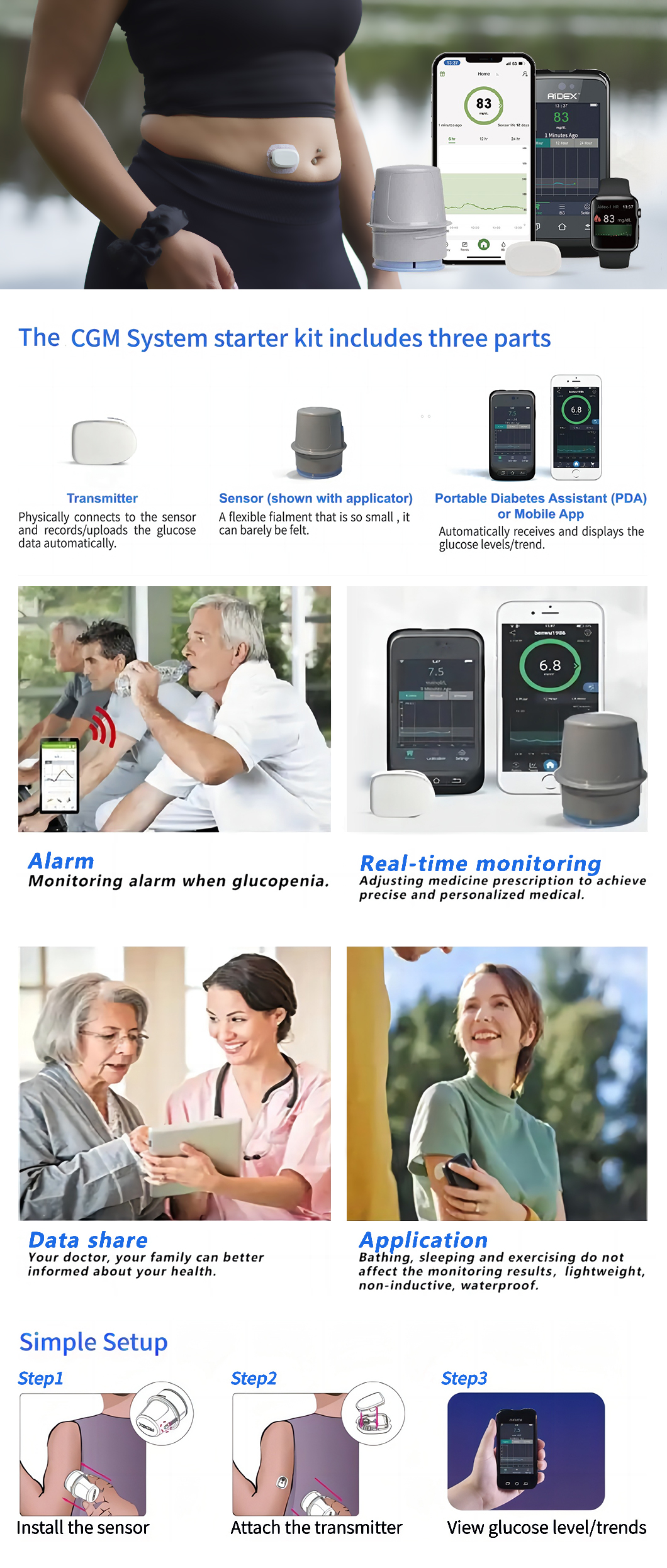- All
- Product Name
- Product Keyword
- Product Model
- Product Summary
- Product Description
- Multi Field Search
| Availability: | |
|---|---|
| Quantity: | |
CNME070520
Non Invasive Continuous Glucose Monitoring System CGM Meter Blood Glucose Monitor
What is continuous glucose monitoring (CGM)?
Continuous glucose monitoring (CGM) is wearable technology that tracks your glucose (sugar) levels over time. It measures the glucose level in the interstitial fluid just under your skin 24 hours a day while you’re wearing the device. People also call it a continuous glucose monitor (a CGM).
A CGM device is mainly a tool for people with diabetes. Managing diabetes involves managing your blood sugar levels. A CGM gives you real-time information on how your glucose levels are changing. This is especially important because several factors affect blood sugar levels — some of which you can’t predict.
How does a continuous glucose monitor (CGM) work?
Sensor: The sensor is a tiny piece of material that measures real-time glucose levels in your interstitial fluid. You’ll insert the sensor under your skin with an applicator. It uses a needle to pierce your skin. You remove the needle, and it leaves the sensor in place. Sensors typically last seven to 15 days, depending on the brand. The implantable CGM system lasts for months. It’s a small pellet (about 18 millimeters long) that a healthcare provider inserts under the skin of your upper arm.
Transmitter: All CGM systems use a transmitter to wirelessly send the glucose data from the sensor to a device where you can view it. For some CGM systems, the transmitter is reusable and attaches to each new sensor. For other CGM systems, the transmitter is part of the disposable sensor.
Smartphone app, receiver or insulin pump: This technology displays your real-time glucose level and shows a graph of the history of your levels. It can also show whether your glucose level is trending up or down — and how drastically. Most CGMs offer smartphone apps for viewing data. Some offer handheld devices if you don’t use a smartphone. Some CGM devices can also send the glucose information to a compatible insulin pump.

Advanced features:
*Waterproof
*Real Time & Accurate
*Comfortable& Easy to Wear
*Hi/Lo Alerts
*Customizable Alerts
*MARD 9.08%
*24/7 Monitoring
*Easy to share
*Reduce HbA1c
*Track Glucose Levels 24/7
*Reduce Hypoglycemic Events
*Identify Diabetic Patterns
Specifications:
Item | Subcomponent | ||
Transmitter | Sensor | PDA | |
Model number | CNME070520-2 | CNME070520-3 | CNME070520-1 |
Operating temperature | 5-40°C(41-104°F) | ||
Operating humidity | 10-93%(non-condensing) | ||
Storage&transportation temperature | -20- 60°C (-4-140°F) | 4-30°C (39.2-86°F) | -20-60°C (-4-140°F) |
Storage& transportation humidity | 5-95%(non-condensing) | ||
Storage& transportation pressure | 700- 1060hpa | ||
Ingress protection level | IPX7 | IPX0 | |
Use life | up to 4 Years | 10 days | 4 Years |
Detection range | 36-450 mg/L(2-25mmol/L) | ||
Non Invasive Continuous Glucose Monitoring System CGM Meter Blood Glucose Monitor
What is continuous glucose monitoring (CGM)?
Continuous glucose monitoring (CGM) is wearable technology that tracks your glucose (sugar) levels over time. It measures the glucose level in the interstitial fluid just under your skin 24 hours a day while you’re wearing the device. People also call it a continuous glucose monitor (a CGM).
A CGM device is mainly a tool for people with diabetes. Managing diabetes involves managing your blood sugar levels. A CGM gives you real-time information on how your glucose levels are changing. This is especially important because several factors affect blood sugar levels — some of which you can’t predict.
How does a continuous glucose monitor (CGM) work?
Sensor: The sensor is a tiny piece of material that measures real-time glucose levels in your interstitial fluid. You’ll insert the sensor under your skin with an applicator. It uses a needle to pierce your skin. You remove the needle, and it leaves the sensor in place. Sensors typically last seven to 15 days, depending on the brand. The implantable CGM system lasts for months. It’s a small pellet (about 18 millimeters long) that a healthcare provider inserts under the skin of your upper arm.
Transmitter: All CGM systems use a transmitter to wirelessly send the glucose data from the sensor to a device where you can view it. For some CGM systems, the transmitter is reusable and attaches to each new sensor. For other CGM systems, the transmitter is part of the disposable sensor.
Smartphone app, receiver or insulin pump: This technology displays your real-time glucose level and shows a graph of the history of your levels. It can also show whether your glucose level is trending up or down — and how drastically. Most CGMs offer smartphone apps for viewing data. Some offer handheld devices if you don’t use a smartphone. Some CGM devices can also send the glucose information to a compatible insulin pump.

Advanced features:
*Waterproof
*Real Time & Accurate
*Comfortable& Easy to Wear
*Hi/Lo Alerts
*Customizable Alerts
*MARD 9.08%
*24/7 Monitoring
*Easy to share
*Reduce HbA1c
*Track Glucose Levels 24/7
*Reduce Hypoglycemic Events
*Identify Diabetic Patterns
Specifications:
Item | Subcomponent | ||
Transmitter | Sensor | PDA | |
Model number | CNME070520-2 | CNME070520-3 | CNME070520-1 |
Operating temperature | 5-40°C(41-104°F) | ||
Operating humidity | 10-93%(non-condensing) | ||
Storage&transportation temperature | -20- 60°C (-4-140°F) | 4-30°C (39.2-86°F) | -20-60°C (-4-140°F) |
Storage& transportation humidity | 5-95%(non-condensing) | ||
Storage& transportation pressure | 700- 1060hpa | ||
Ingress protection level | IPX7 | IPX0 | |
Use life | up to 4 Years | 10 days | 4 Years |
Detection range | 36-450 mg/L(2-25mmol/L) | ||